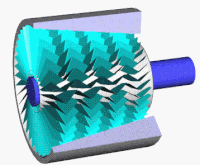
Photo from wikipedia
Abstract With the advancements in manufacturing, materials and computational methods, turbomachinery designs have become more efficient providing higher specific power and reliability with lower weight and cost. The rotational speed… Click to show full abstract
Abstract With the advancements in manufacturing, materials and computational methods, turbomachinery designs have become more efficient providing higher specific power and reliability with lower weight and cost. The rotational speed of turbomachines has increased while the overall machine size has decreased for a similar power output leading to the pervasive presence of small, high-speed turbomachines, specifically centrifugal compressors in helicopters, unmanned aerial vehicles (UAVs), auxiliary power units (APUs), turbochargers and micro gas turbines. In addition to superior aerodynamic performance over a wide range, increased operating speeds have made the acoustic emissions of small centrifugal compressors a critical aspect of design. Therefore, this work presents an experimental campaign to characterise the acoustic behaviour of a compressor with an intent to quantify the dominant features of the flow-induced noise for design and near surge operating conditions. Furthermore, the campaign is extended to establish the impact of the ported shroud casing treatment and operating speed on the acoustic emission of the compressor. The in-duct noise measurement method is used in this work to quantify the noise generated in the compressor by measuring pressure fluctuations near the inducer and diffuser while the propagation of the generated noise to the ducts is computed from an array of piezoelectric sensors. Spectra at the design operating point are dominated by tonal noise while broadband noise content is the dominant feature of spectra for near surge operation. Although the ported shroud cavity does not significantly alter the overall noise levels of the compressor operating at design condition, it does seem to propagate tonal noise. For near surge operation, the casing treatment positively impacts the acoustic emission with a reduction of approximately 10 dB in the range up to the blade pass frequency. Furthermore, various broadband features are also observed to be alleviated by the casing treatment.
Journal Title: Aerospace Science and Technology
Year Published: 2019
Link to full text (if available)
Share on Social Media: Sign Up to like & get
recommendations!